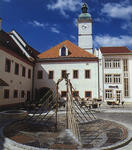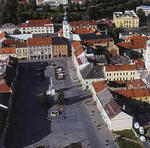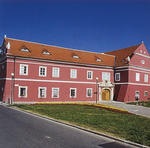
Uherske Hradiste stands for Moravian Slovakia, a racy region with image composed of
typical folklore, dulcimer music, good wine, beautiful national costumes and lively folk traditions.
The country around is as manifold as can be, with special natural features, the Morava River (the March), extensive forests and rich, original flora and fauna, picturesque highlands and agricultural land.
Tourist's attractions include the memorable castle of Velehrad, the chateau of Buchlovice, the Buchlov Castle, all of these quite close to the town, and the town's own sights. Founded in 1257 by Premysl Otakar II., Uherske Hradiste was a defence fortress against Hungarian raids. But numerous archaeological finds testify to much older settlements. There are a few Palaeolithic artifacts, traces of Neolithic settlements and of a culture characteristic for painted and rope ceramics, testimonies of Celtic and Roman presence. The place had been one of Great Moravia's important centres as shown by archaeological
exhibitions of the Great Moravian Memorial at Stare Mesto (foundation of a church and cemetery plus foundations of another church dating back to the third quarter of the 9
th century at Valy) and at Sady (remainders of a temple complex.) There are many interesting architectural sights in the town itself, like the remainders of the 15
th century town walls with the Mattthew's Gate, a late-17
th century baroque fountain, and many burgher houses. The highest value of all has been assigned to the late-Gothic 15
th century town hall; the Plague Post erected in the middle of the Vigin Mary Square in 1721; the Franciscan Monastery with a refectory from 1490; the Jesuit Church and college from 1643; and the 14
th century St Elisabeth's Hospital Chapel. The new Town Hall was built in 1891-93 and is adorned with Joza Uprka's frescos

in the ceremonial hall which depict the founding of the town by Premysl Otakar II. and the confirmation of privileges by King George of Podebrady. Serving as Gallery of the Slovacke Museum, the old baroque armoury arsenal is unique.
The Museum's main part has been accommodated in a house reconstructed in 1936 and again in 1940-42 by architect B. Fuchs.
The local cultural life has several highlights the Festivals of Folk Music Instruments; the Summer Film School; the envi ronmentalist forum "It concerns you, too";
Buchlovska svica, the international cast medal, plaque and plastic art symposium. There are several centres of cultural activities: the theatre Slovacke divadlo; Slovacke Museum with collections of national history; School of Industrial Design; the Culture Club, cinemas and galleries.
Cultivating folk traditions, several clubs and ensembles organise many modest events, like feasts in some neighbourhoods, chat around the dulcimer, concerts. Fairs and days on which memorable places open doors to the public have become a tradition.
Last few years have been characteristic of turbulent building development and redevelopment of the historical core. Uherske Hradiste is assuming a friendlier face with many services, shops and fun.



 Guide
Guide 





